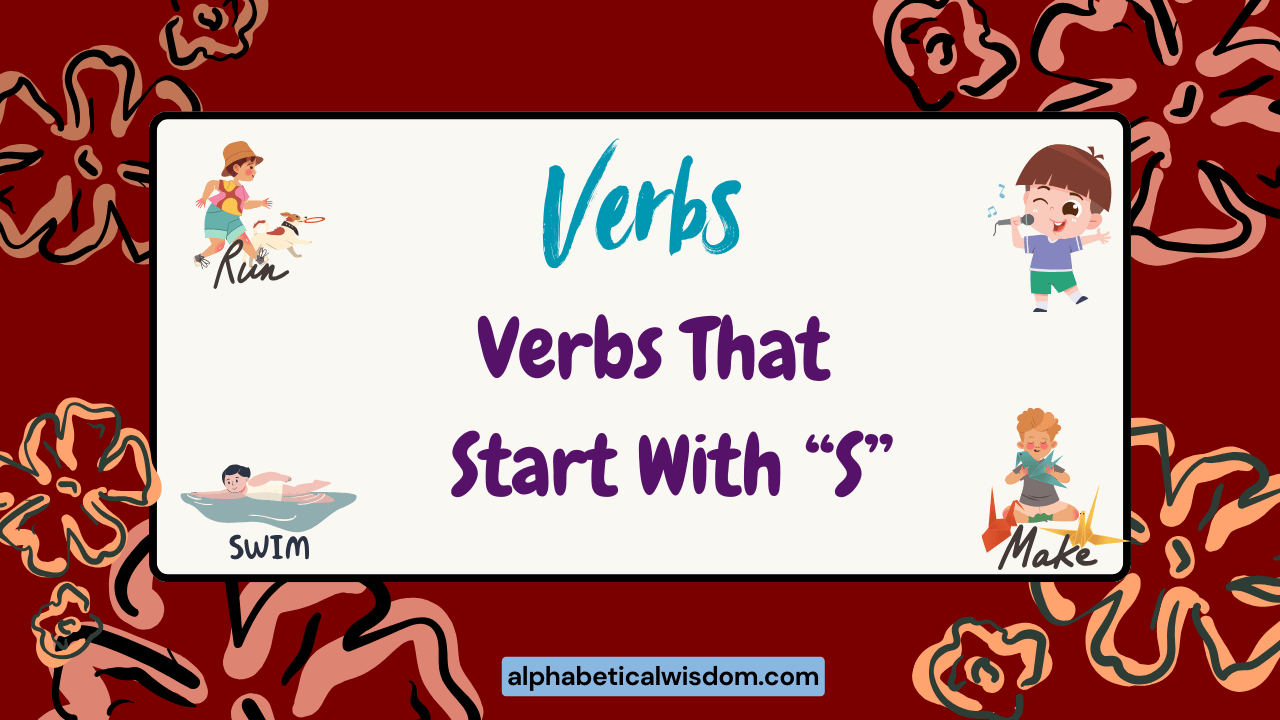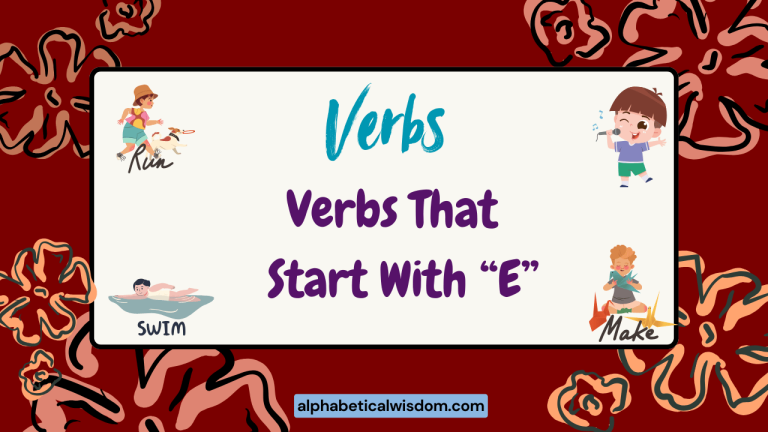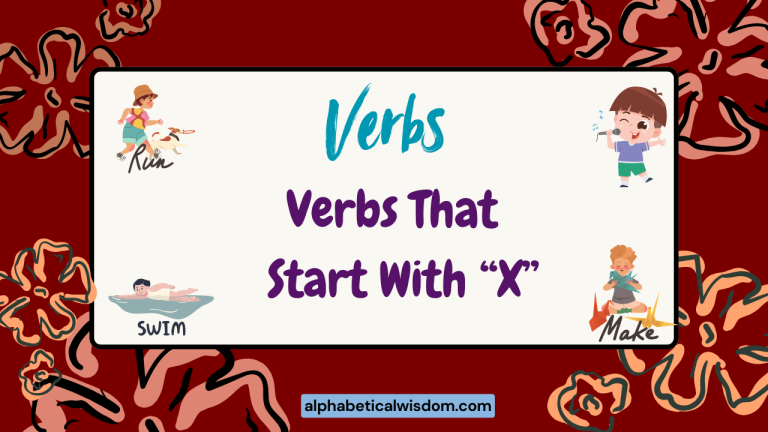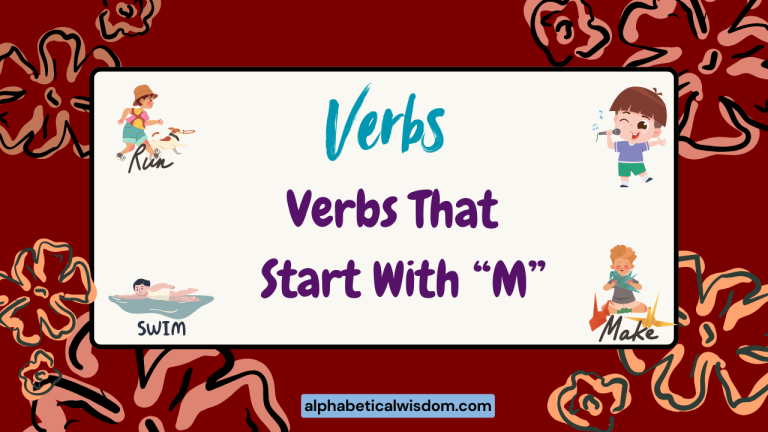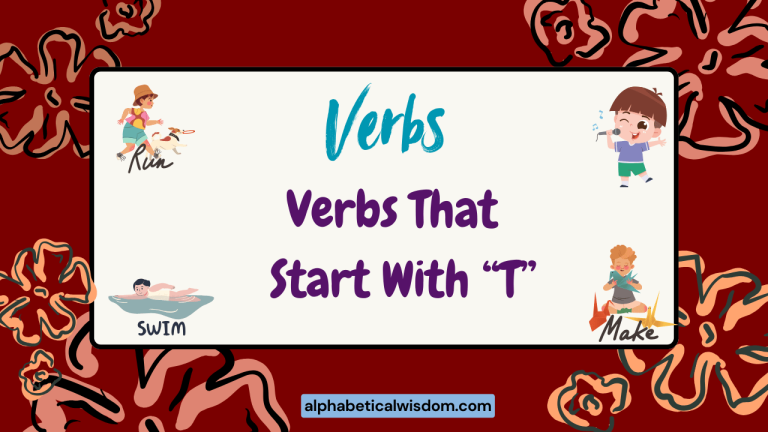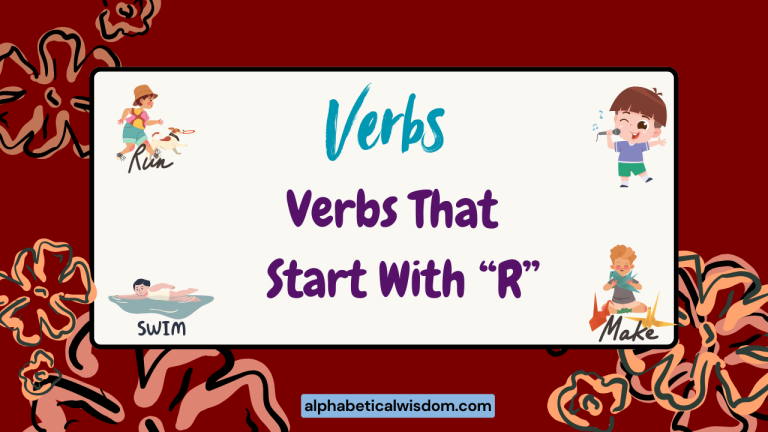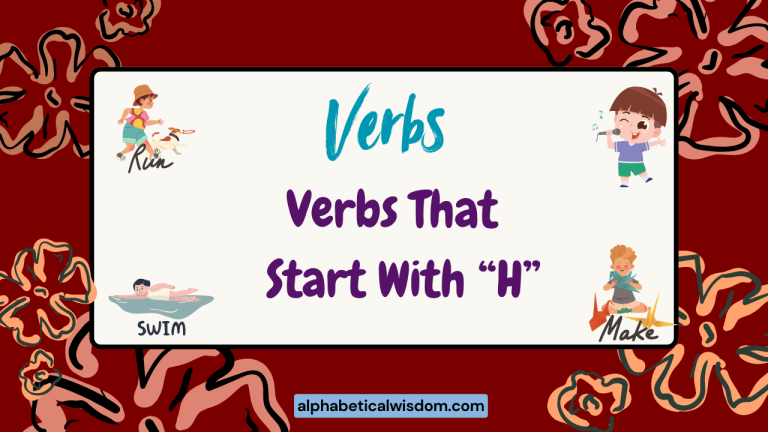Verbs That Start With S: A Comprehensive Guide to Usage
Verbs are the backbone of any sentence, conveying actions, occurrences, or states of being. Among the vast array of verbs in the English language, those starting with the letter “S” hold a significant place.
Mastering these verbs is essential for clear and effective communication. This article offers a deep dive into verbs that start with “S,” exploring their definitions, structures, usage rules, and common pitfalls.
Whether you’re an ESL learner, a student, or simply someone looking to enhance their grammar skills, this guide provides the knowledge and practice you need to confidently use these verbs in your writing and speech.
Table of Contents
- Introduction
- Definition of Verbs Starting with S
- Structural Breakdown of S Verbs
- Types of Verbs Starting with S
- Examples of Verbs Starting with S
- Usage Rules for Verbs Starting with S
- Common Mistakes with S Verbs
- Practice Exercises
- Advanced Topics
- Frequently Asked Questions
- Conclusion
Definition of Verbs Starting with S
Verbs starting with “S” are action words, states of being, or occurrences that begin with the letter “S.” They function just like any other verb in the English language, serving as the predicate of a sentence or clause. These verbs can be transitive, requiring a direct object, or intransitive, not requiring one.
They can also be regular, following standard conjugation patterns (adding -ed for past tense), or irregular, having unique past tense and past participle forms.
The context in which an “S” verb is used dictates its specific meaning and grammatical role. For instance, the verb “sing” describes an action performed by someone, while the verb “seem” expresses a state of being or appearance.
The verb “should” functions as a modal auxiliary verb, expressing obligation or advice.
Structural Breakdown of S Verbs
The structure of verbs starting with “S” doesn’t differ significantly from other verbs. They follow the standard verb conjugation patterns in English.
They can be used in various tenses (present, past, future), aspects (simple, continuous, perfect), and moods (indicative, imperative, subjunctive). Regular verbs typically form their past tense and past participle by adding “-ed” or “-d.” Irregular verbs, however, have unique forms that must be memorized.
For example, “see” becomes “saw” in the past tense and “seen” in the past participle. The verb “say” becomes “said” in both the past tense and past participle.
Understanding the conjugation patterns of both regular and irregular verbs starting with “S” is vital for constructing grammatically correct sentences. Consider the verb “start.” Its past tense is “started,” and its past participle is also “started.” In contrast, the verb “sing” has the past tense “sang” and the past participle “sung.” These variations highlight the importance of learning each verb’s unique forms.
Types of Verbs Starting with S
Verbs starting with “S,” like all verbs, can be categorized based on their function and meaning in a sentence. The main categories include action verbs, stative verbs, linking verbs, and auxiliary verbs.
Action Verbs
Action verbs describe physical or mental actions. They are the most common type of verb and directly express what the subject is doing.
Action verbs starting with “S” include “swim,” “sing,” “speak,” “study,” and “search.” These verbs often take a direct object, indicating the receiver of the action, but they can also be intransitive.
Stative Verbs
Stative verbs describe a state of being, a condition, or a mental state rather than an action. They often relate to thoughts, emotions, relationships, senses, or measurements.
Examples of stative verbs starting with “S” include “seem,” “suppose,” “satisfy,” “sound,” and “stay.” These verbs are generally not used in continuous tenses because they describe a continuous state rather than an ongoing action.
Linking Verbs
Linking verbs connect the subject of a sentence to a noun or adjective that describes or identifies the subject. They do not express an action.
Common linking verbs starting with “S” include “seem,” “sound,” “stay,” and sometimes “smell” and “stay” when they connect the subject to a descriptive word. The verb “be” in its various forms (is, are, was, were, been, being) is the most common linking verb, but these “S” verbs can also fulfill this function.
Auxiliary Verbs
Auxiliary verbs, also known as helping verbs, assist the main verb in a sentence. They add grammatical information such as tense, mood, or voice.
While not many auxiliary verbs start with “S,” “shall” and “should” are important examples. “Shall” is used to form the future tense (though less common in modern English), and “should” expresses obligation, advice, or possibility.
Examples of Verbs Starting with S
To illustrate the usage of verbs starting with “S,” let’s examine examples categorized by verb type.
Action Verb Examples
The following table provides examples of action verbs starting with “S” used in sentences. Note how these verbs describe specific actions performed by the subject.
| Verb | Sentence |
|---|---|
| Swim | She swims every morning at the community pool. |
| Sing | The choir sings beautifully during the Christmas service. |
| Speak | He speaks fluent Spanish and English. |
| Study | They study diligently for their upcoming exams. |
| Search | The police searched the area for clues. |
| Smile | She smiled when she saw her friend. |
| Solve | He solved the complex math problem quickly. |
| Spend | They spend their weekends volunteering at the local shelter. |
| Share | Please share your ideas with the team. |
| Shout | He shouted to get their attention. |
| Shake | The dog shook its head to dry off. |
| Sweep | She sweeps the floor every day. |
| Scream | The child screamed when he saw the spider. |
| Scratch | The cat scratched the furniture. |
| Sew | She sews her own clothes. |
| Sail | They sail across the ocean every summer. |
| Serve | He serves the community by volunteering. |
| Set | She sets the table before dinner. |
| Settle | They settled in a small town after retiring. |
| Shift | He shifts the blame onto others. |
| Shine | The sun shines brightly in the morning. |
| Ship | The company ships products worldwide. |
| Shop | They shop for groceries every Saturday. |
| Signal | He signaled the driver to stop. |
| Ski | They ski down the mountain in winter. |
| Skip | She skips rope for exercise. |
| Slap | He accidentally slapped his knee on the table. |
| Slide | The children slide down the playground slide. |
| Slip | She slipped on the ice and fell. |
Stative Verb Examples
The following table provides examples of stative verbs starting with “S.” These verbs describe states of being or conditions, not actions. Consequently, they are rarely used in continuous tenses.
| Verb | Sentence |
|---|---|
| Seem | He seems tired today. |
| Suppose | I suppose that’s a good idea. |
| Satisfy | The results satisfy the requirements. |
| Sound | That sounds like a great plan. |
| Stay | They stay at home on Sundays. |
| Stink | Something stinks in the kitchen. |
| Suffice | This amount suffices for the task. |
| Suspect | I suspect he is lying. |
| See | I see what you mean. |
| Smell | The roses smell lovely. |
| Suit | This arrangement suits my needs perfectly |
| Savor | I savor the taste of good coffee in the morning. |
| Stun | The news stunned everyone in the room. |
| Support | I support your decision. |
| Seek | I seek answers to these questions. |
| Sense | I sense something is not right. |
Linking Verb Examples
The following table illustrates linking verbs starting with “S.” These verbs connect the subject to a word that describes or identifies it.
| Verb | Sentence |
|---|---|
| Seem | She seems happy. |
| Sound | The idea sounds interesting. |
| Stay | They stay calm under pressure. |
| Smell | The flowers smell fragrant. |
| Stay | The soup stayed warm in the pot. |
Auxiliary Verb Examples
The following table shows how “shall” and “should” are used as auxiliary verbs to express future tense, obligation, or advice.
| Verb | Sentence |
|---|---|
| Shall | We shall overcome. |
| Should | You should study more. |
| Should | They should arrive soon. |
| Should | She should have called me. |
Usage Rules for Verbs Starting with S
Proper usage of verbs starting with “S” involves understanding subject-verb agreement, tense consistency, and the specific nuances of each verb. Subject-verb agreement means that the verb form must match the subject in number (singular or plural).
Tense consistency requires maintaining a consistent tense throughout a sentence or paragraph unless there’s a logical reason to change.
For regular verbs, forming the past tense and past participle is straightforward: simply add “-ed” or “-d.” However, irregular verbs require memorization of their unique forms. Additionally, be mindful of the difference between transitive and intransitive verbs.
Transitive verbs must be followed by a direct object, while intransitive verbs do not take a direct object.
Understanding the subtle differences in meaning between similar verbs is also crucial. For example, “see,” “look,” and “watch” all involve visual perception, but they have distinct connotations.
“See” simply means to perceive with your eyes. “Look” implies intentional direction of your gaze.
“Watch” suggests paying attention to something over a period of time. Using the correct verb depends on the specific context and desired meaning.
Here are some core rules to remember:
* **Subject-Verb Agreement:** The verb must agree in number with its subject. For example:
* Singular: *He sings.*
* Plural: *They sing.*
* **Tense Consistency:** Maintain consistent tense throughout a sentence or paragraph. For example: *She studied hard and passed the exam.* (Both verbs are in the past tense).
* **Transitive vs. Intransitive:** Use transitive verbs with a direct object and intransitive verbs without one.
* Transitive: *She sings a song.* (“song” is the direct object)
* Intransitive: *The bird sings.* (no direct object)
Common Mistakes with S Verbs
One common mistake involves irregular verb forms. For example, using “seed” instead of “saw” as the past tense of “see” is incorrect.
Another frequent error is using stative verbs in continuous tenses. Saying “I am seeming tired” is grammatically incorrect; the correct form is “I seem tired.” Also, confusion between similar verbs like “say” and “tell” is common.
“Say” is used to express words, while “tell” requires a listener. “He said that he was tired” is correct, while “He told that he was tired to me” would be incorrect and should be “He told me that he was tired”.
Here are some specific examples of common mistakes and their corrections:
| Incorrect | Correct | Explanation |
|---|---|---|
| I am seeing the movie. | I see the movie. | “See” is a stative verb and is not typically used in continuous tenses when referring to understanding. |
| He sayed he was coming. | He said he was coming. | “Said” is the correct past tense of “say.” |
| She should went to the store. | She should have gone to the store. | “Should have” is followed by the past participle “gone,” not the past tense “went.” |
| They was studying. | They were studying. | The plural subject “they” requires the plural form “were.” |
| He seed the bird. | He saw the bird. | “Saw” is the correct past tense of “see.” |
| I am supposing that is right. | I suppose that is right. | “Suppose” is a stative verb and is not typically used in continuous tenses. |
Practice Exercises
The following exercises will help you practice using verbs starting with “S” correctly.
Exercise 1: Identifying Verb Types
Identify whether the verbs starting with “S” in the following sentences are action, stative, linking, or auxiliary.
| Sentence | Verb | Type | Answer |
|---|---|---|---|
| She sings in the choir. | sings | Action/Stative/Linking/Auxiliary | Action |
| He seems upset. | seems | Action/Stative/Linking/Auxiliary | Linking |
| You should study harder. | should | Action/Stative/Linking/Auxiliary | Auxiliary |
| The soup smells delicious. | smells | Action/Stative/Linking/Auxiliary | Linking |
| I suppose that’s true. | suppose | Action/Stative/Linking/Auxiliary | Stative |
| The sun shines brightly. | shines | Action/Stative/Linking/Auxiliary | Action |
| The plan sounds good. | sounds | Action/Stative/Linking/Auxiliary | Linking |
| They should have arrived already. | should | Action/Stative/Linking/Auxiliary | Auxiliary |
| She swims every day. | swims | Action/Stative/Linking/Auxiliary | Action |
| He seems to be hiding something. | seems | Action/Stative/Linking/Auxiliary | Linking |
Exercise 2: Correct Verb Forms
Fill in the blanks with the correct form of the verb starting with “S” provided in parentheses.
| Sentence | Verb (Infinitive) | Answer |
|---|---|---|
| Yesterday, I ________ (see) a bird. | see | saw |
| She ________ (sing) beautifully at the concert. | sing | sang |
| He ________ (speak) three languages fluently. | speak | speaks |
| They ________ (study) for their exams every night. | study | study |
| We ________ (search) for the missing keys. | search | are searching |
| She ________ (smile) when she saw the puppy. | smile | smiled |
| He ________ (solve) the puzzle in minutes. | solve | solved |
| They ________ (spend) their vacation in Hawaii last year. | spend | spent |
| Please ________ (share) your thoughts with us. | share | share |
| He ________ (shout) for help when he fell. | shout | shouted |
Exercise 3: Sentence Completion
Complete the following sentences with an appropriate verb starting with “S.”
| Sentence | Possible Answer |
|---|---|
| The flowers ________ lovely. | smell |
| He ________ to be a good student. | seems |
| We ________ overcome this challenge. | shall |
| You ________ always tell the truth. | should |
| She ________ the ball to her friend. | threw |
| The children ________ in the park. | swung |
| He ________ the door shut. | slammed |
| They ________ the problem easily. | solved |
| She ________ her opinion with confidence. | shared |
| The sun ________ brightly in the sky. | shone |
Advanced Topics
For advanced learners, exploring the subjunctive mood and phrasal verbs involving verbs starting with “S” can further enhance their understanding of English grammar.
Subjunctive Mood
The subjunctive mood expresses a wish, a suggestion, a command, or a hypothetical situation. Verbs starting with “S” can appear in the subjunctive mood, particularly in clauses beginning with “that” after verbs like “suggest,” “stipulate,” or “demand.” For example, “I suggest that he *study* harder” (not “studies”).
The base form of the verb is used in the subjunctive mood, regardless of the subject’s number.
Consider the following examples:
* It is essential that she *submit* the application on time.
* The doctor suggested that he *stop* smoking immediately.
* They demanded that the company *settle* the dispute fairly.
Phrasal Verbs
Phrasal verbs consist of a verb and a particle (preposition or adverb) that together create a new meaning. Many phrasal verbs start with “S.” Understanding these phrasal verbs is essential for fluent English.
Examples include “set up” (to establish), “sort out” (to resolve), “stand for” (to represent), “show up” (to arrive), and “shut down” (to close). The meaning of a phrasal verb is often different from the meaning of the individual words.
Here are some examples of phrasal verbs with “S” and their meanings:
* **Set up:** to establish or arrange something. *Example: They set up a new business.*
* **Sort out:** to resolve a problem or organize something. *Example: Please sort out these documents.*
* **Stand for:** to represent or support something. *Example: The acronym stands for “National Aeronautics and Space Administration.”*
* **Show up:** to arrive or appear. *Example: He didn’t show up to the meeting.*
* **Shut down:** to close or stop operating. *Example: The factory shut down due to financial problems.*
* **Settle down:** to become calm or quiet. *Example: The children settled down after the story.*
* **Sign up:** to register or enroll in something. *Example: She signed up for the course.*
* **Slow down:** to reduce speed. *Example: Please slow down while driving in residential areas.*
Frequently Asked Questions
- What are the most common verbs starting with “S”?
Some of the most common verbs starting with “S” include “say,” “see,” “seem,” “should,” “sing,” “speak,” “start,” “study,” “search,” “stay,” and “suppose.” These verbs are frequently used in everyday conversation and writing.
- How do I know if a verb starting with “S” is transitive or intransitive?
A transitive verb requires a direct object, while an intransitive verb does not. To determine whether a verb is transitive or intransitive, ask “Who?” or “What?” after the verb. If you can identify a direct object that answers the question, the verb is transitive. If not, it is intransitive. For example, in the sentence “She sings a song,” “song” is the direct object, so “sings” is transitive. In the sentence “The bird sings,” there is no direct object, so “sings” is intransitive.
- Can stative verbs starting with “S” ever be used in continuous tenses?
Generally, stative verbs are not used in continuous tenses because they describe states rather than actions. However, some stative verbs can be used in continuous tenses when their meaning shifts to describe a temporary action or behavior. For example, “He is seeming tired” is incorrect, but “He is being difficult” is acceptable because “being” describes a temporary behavior.
- What is the difference between “say” and “tell”?
“Say” is used to express words or statements, while “tell” requires a listener or recipient of the information. You “say” something, but you “tell” someone something. For example, “He said that he was tired” is correct, while “He told me that he was tired” is also correct.
- How do I use “shall” correctly?
“Shall” is primarily used with “I” and “we” to form the future tense, although it is less common in modern English, especially in American English. It can also be used to make suggestions or offers. For example, “I shall go to the store later” or “Shall we dance?”.
- What are some common phrasal verbs starting with “S”?
Some common phrasal verbs starting with “S” include “set up,” “sort out,” “stand for,” “show up,” “shut down,” “settle down,” “sign up,” and “slow down.” Each of these phrasal verbs has a unique meaning that may not be obvious from the individual words.
- How do I improve my vocabulary of verbs that start with ‘S’?
Reading widely, using a dictionary and thesaurus, and practicing using new words in sentences are all effective strategies. Flashcards and vocabulary apps can also be helpful tools for memorizing new verbs.
- Are there any regional differences in the usage of verbs starting with ‘S’?
While most verbs starting with ‘S’ are used consistently across different English-speaking regions, there might be slight variations in the frequency or context of their usage. For instance, certain phrasal verbs or idiomatic expressions involving ‘S’ verbs might be more common in specific regions. It is important to be aware of these potential differences when communicating with people from diverse backgrounds.
- How can I practice using verbs starting with ‘S’ in my writing?
Engage in regular writing exercises, such as journaling, essay writing, or creative writing prompts. Focus on incorporating a variety of verbs starting with ‘S’ into your writing to enhance clarity and precision. Additionally, seek feedback from teachers, peers, or online writing communities to identify areas for improvement. Pay close attention to the context and usage of each verb to ensure grammatical accuracy and effective communication.
Conclusion
Mastering verbs starting with “S” is crucial for effective communication in English. By understanding their definitions, structures, types, and usage rules, you can confidently use these verbs in your writing and speech.
Pay attention to subject-verb agreement, tense consistency, and the nuances of each verb. Practice regularly to avoid common mistakes and expand your vocabulary.
With consistent effort, you can enhance your grammar skills and express yourself more clearly and accurately.
Remember to review the examples and exercises provided in this article to reinforce your learning. Continue to read and listen to English content to expose yourself to a wide range of verbs starting with “S” in various contexts.
With dedication and practice, you’ll become proficient in using these verbs and elevate your overall English language skills. Good luck!
